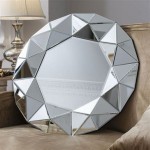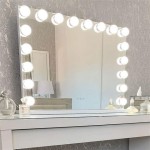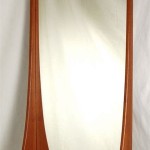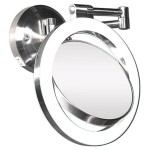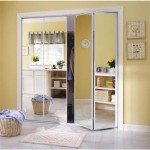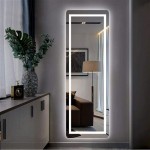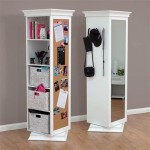How to Angle a Mirror on a Wall Without Nails
Hanging a mirror traditionally involves nails or screws, leaving permanent holes in the wall. However, various damage-free methods allow for flexible mirror placement and easy removal without compromising aesthetics. This article explores different techniques for angling a mirror on a wall without using nails, catering to diverse needs and wall types.
1. Adhesive Hooks and Strips
Adhesive hooks and strips offer a convenient and versatile solution for hanging mirrors without nails. These products utilize advanced adhesive technology to securely hold mirrors of varying weights. Selecting the appropriate type and weight capacity is crucial for ensuring stability.
Key Points:
- Clean the wall surface thoroughly with isopropyl alcohol before application to maximize adhesion.
- Follow manufacturer instructions precisely for optimal bonding.
- Consider using multiple hooks or strips for larger or heavier mirrors to distribute the weight evenly.
- Certain adhesive strips are designed for specific surfaces like tiles or brick; choose accordingly.
- Test the adhesion strength after the recommended curing time before hanging the mirror.
2. Leaning Mirrors
Leaning a mirror against a wall offers a simple, nail-free approach. This method eliminates the need for any wall attachments and allows for effortless repositioning. However, stability considerations are essential, particularly in households with children or pets.
Key Points:
- Position the mirror on a stable surface and at a safe angle to prevent tipping.
- Use non-slip pads on the base of the mirror to enhance stability and protect flooring.
- Consider securing the mirror to the wall with discreet, removable adhesive for added safety.
3. Mirror Mounting Tape
Mirror mounting tape provides a strong and permanent bonding solution for affixing mirrors directly to walls. This double-sided tape is specifically designed for mirrors and offers high load-bearing capacity. Accurate placement is crucial, as adjustments after application can be difficult.
Key Points:
- Clean both the wall surface and the back of the mirror thoroughly before applying the tape.
- Apply the tape in vertical strips along the back of the mirror, leaving space between strips for air circulation.
- Press the mirror firmly against the wall for the duration specified by the manufacturer's instructions.
- Use support props for larger mirrors until the adhesive fully cures.
4. Adjustable Mirror Brackets
Adjustable mirror brackets offer a secure and flexible hanging solution without requiring permanent wall fixtures. These brackets grip the edges of the mirror and can be adjusted to achieve the desired angle. They are typically attached to the wall using adhesive strips or hooks.
Key Points:
- Select brackets appropriate for the size and weight of the mirror.
- Ensure that the brackets are compatible with the chosen adhesive method.
- Adjust the brackets to achieve the desired angle before securing them to the wall.
5. Wall-Mounted Stands or Easels
Utilizing a wall-mounted stand or easel specifically designed for mirrors provides a unique and decorative approach. These stands are typically freestanding and can be positioned against the wall without any permanent attachments. They often feature adjustable angles for customization.
Key Points:
- Choose a stand or easel with a stable base and appropriate weight capacity.
- Consider the size and style of the mirror in relation to the stand or easel's design.
- Ensure that the stand or easel's dimensions fit within the desired space.
6. Wire or Cord Suspension Systems
While traditional wire suspension systems often involve nails, adaptations can be made to avoid wall damage. Using adhesive hooks instead of nails to anchor the wires allows for a secure and adjustable hanging method. This method is particularly useful for larger or heavier mirrors.
Key Points:
- Select a strong and durable wire or cord capable of supporting the mirror's weight.
- Use heavy-duty adhesive hooks rated for the combined weight of the mirror and wire system.
- Ensure the hooks are positioned symmetrically to distribute the weight evenly.
- Adjust the wire length to achieve the desired hanging height and angle.
7. Temporary Hooks for Lighter Mirrors
For smaller, lightweight mirrors, temporary adhesive hooks provide a quick and easy solution. These hooks are designed for easy removal without leaving residue, making them ideal for renters or those who frequently redecorate. However, they are not suitable for heavier mirrors.
Key Points:
- Check the weight limit of the temporary hooks before use.
- Clean the wall surface before application to ensure proper adhesion.
- Follow the manufacturer’s instructions for removal to minimize the risk of surface damage.
How To Hang A Heavy Mirror On Drywall Without Damaging It Or The Wall Quora

How To Hang A Frameless Mirror On The Wall With Pictures
How To Hang A Mirror On Wall Without Nails Quora

Best Way To Hang A Mirror On The Wall Fast Easy Without Nails

How To Hang A Frameless Mirror On The Wall With Pictures

Best Way To Hang A Mirror On The Wall Fast Easy Without Nails

How To Hang A Frameless Mirror On The Wall With Pictures
How To Hang A Mirror On Wall Without Nails Quora

How To Hang A Wall Mirror Easy Mounting Instructions
Options For Hanging Frame Mirror In Bathrooom The Picture Framers Grumble

